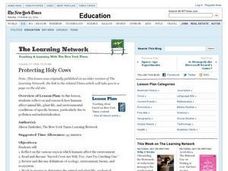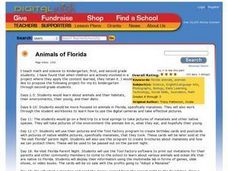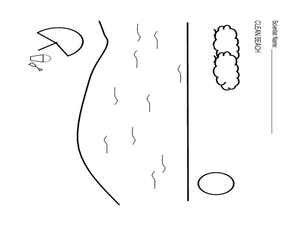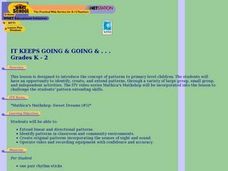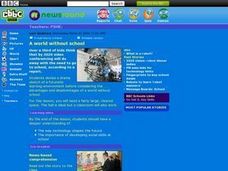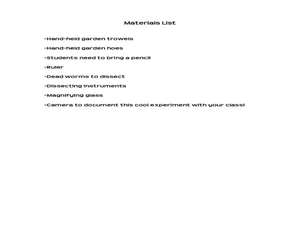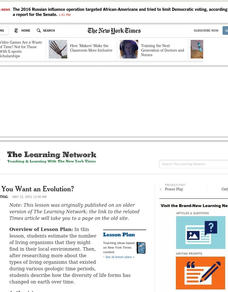Curated OER
Camouflage
Third graders collect insects and various bits of the insects' habitats in order to develop an understanding of how camouflage makes the insect fit to survive in its environment.
Curated OER
Bugging Out
Students explore how insects behave in their natural habitats and build dioramas to create an Insect World in their classroom. They investigate various insects and the roles they play in the environment. They write creative short...
Curated OER
Functions and Statistics: International Space Station: Up to Us
Students explore how the International Space Station was built and how it provides first-hand experiences with the space program. They view the NASA engineers discussing the major components of the International Space Station, their...
Curated OER
Protecting Holy Cows
Students study the interrelationships of organisms and their environments. They study ecological communities and determine what is necessary for survival. Students discuss and answer questions concerning a group's biome, habitat, food...
Curated OER
Biomes: Land of the Inuit
Students study Inuit and their ancestors. In this biomes activity students study the relationship between the Inuit and their environment and create a class art gallery.
Curated OER
Chain Reaction
Learners study animal behavior and how it changes to its environment. In this animal lesson students design and conduct experiments.
Curated OER
Animals Of Florida
Students study about animals and their habitats, their environments, their young and their diets. They participate on a field trip to a local spring to take digital pictures of the environment the animals live in, what they eat and then...
Curated OER
Fish Hazards
Students study the Pacific salmon and see the different challenges they face. In this environment lesson students complete several activities that show how humans have affected the salmon environment. These activities have varying...
Curated OER
CONVECTION
Students experiment to produce a visual convection current in the classroom and compare it to the images taken of convection cells in the Sun. They analyze the source of the Sun's energy and this type of energy transport.
Curated OER
It Keeps Going & Going &...
Students extend linear and directional patterns, identify patterns in classroom and community environments, create original patterns incorporating the senses of sight and sound, and operate video and recording equipment.
Curated OER
The Earth Day Groceries Project
Students research Earth Day and make bags to hand out on Earth Day to help promote taking care of the environment.
Curated OER
A World Without A School
Young scholars devise a drama sketch of a futuristic learning environment before considering the advantages and disadvantages of a world without schools. Students role play their creations within the hall or classroom.
Curated OER
Get to Know a Fish
Students discover the anatomy of a fish by identifying its body parts. In this oceanography lesson, students view a live fish in their classroom and draw a poster of the fish one body part at a time while identifying it. Students...
Curated OER
Water Wonders
Students explore hydrology concepts. In this environment and biology instructional activity, students identify and describe macroinvertebrates using a variety of pictures and resources. Students observe and write about a classroom...
Curated OER
Scientific Inquiry, Episode 1
Students look at ways to help the environment. In this recycling lesson, students watch a video on pollution and then collect trash at their school. They create posters to share with the school about the importance of recycling.
Curated OER
A Science Trail: Worms
Third graders explore worms in multiple ways. In this lesson on worms, 3rd graders search for worms in their natural environment, record data on worms, and dissect worms.
Curated OER
Can Worms See?
Second graders discuss the previously created worm compost and the importance of living creatures to the Environment. In this worm lesson, 2nd graders observe worms and record their sensitivity to light. Students design a petri dish...
Curated OER
What is Coral?
Students discuss what they know about coral reefs and are introduced to the importance of preserving coral reefs. In this coral reef instructional activity, students make connections between coral ecology in the classroom and in the real...
Curated OER
Why Is My Bread Fuzzy?
Students explore the organisms that live on counters or surfaces in the classroom. In this mold experiment, students observe mold in different conditons. Students record their observations on a worksheet. Students understand how mold...
Curated OER
You Say You Want an Evolution?
Learners estimate the number of living organisms they might find in their local environment. After researching the types of organisms that existed during various geologic time periods, students describe how life forms have changed over...
Curated OER
Two-Dimensional Geometric Shapes
Students participate in hands-on activities to explore the shapes in their environment.
Curated OER
Exploring the Web of Life
Young scholars develop a classroom definition of and explore ideas related to ecosystems. They create a food web using pictures and yarn.
Curated OER
Garden of Eden
Students view a video clip about animals and their habitats. They work together to discuss how different animals adapt to their environments. They create a new habitat for a specific animal and draw new adaptations for them.
Curated OER
Biology: Plants - The Fiber of Life
Learners, in groups, examine and list the varieties of plants and how they relate to man and the environment. They create plant books complete with leaf samples with sketches and information, grow beans in plastic baggies, and role-play...





